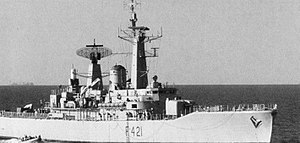
| |
| History | |
|---|---|
| Name | HMNZS Canterbury (F421) |
| Namesake | Canterbury Region |
| Operator | Royal New Zealand Navy |
| Builder | Yarrow Shipbuilders |
| Laid down | 12 June 1969 |
| Launched | 6 May 1970 |
| Commissioned | 22 October 1971 |
| Decommissioned | 21 March 2005 |
| Homeport | Lyttelton |
| Fate | Scuttled 3 November 2007 as an artificial reef |
| General characteristics | |
| Class and type | Leander-class frigate |
| Displacement | 2,945 tonnes full load |
| Length | 113.4 m (372 ft) |
| Beam | 13.1 m (43 ft) |
| Draught | 5.5 m (18 ft) |
| Propulsion |
|
| Speed | 28 knots (52 km/h; 32 mph) |
| Range | 3,000 nautical miles (5,600 km; 3,500 mi) at 15 knots (28 km/h; 17 mph) |
| Endurance | 30 days or 5,500 nautical miles (10,200 km; 6,300 mi) at 15 knots (28 km/h; 17 mph) |
| Complement | 245 + 15 officers |
| Sensors and processing systems |
|
| Armament |
|
| Aircraft carried |
|
HMNZS Canterbury (F421) was one of two broad beam Leander-class frigates operated by the Royal New Zealand Navy (RNZN) from 1971 to 2005. She was built in Scotland and launched in 1970. Commissioned in 1971, Canterbury saw operational service in much of Australasia and other regions like the Persian Gulf. She undertook operations such as supporting UN sanctions against Iraq and peace-keeping in East Timor. With her sister ship HMNZS Waikato she relieved the Royal Navy frigate HMS Amazon in the Indian Ocean during the Falklands War. Early in HMNZS Canterbury's career, in 1973, she relieved the frigate HMNZS Otago, as part of a unique, Anzac, naval operation or exercise at Moruroa during anti-nuclear protests, supported by a large RAN tanker, providing fuel and a large platform for Australian media. This was due to F 421 being a more modern RNZN frigate, with then current Rn surveillance radar and ESM and a more effectively insulated frigate from nuclear fallout, with the Improved Broad Beam Leander steam plant, for example, being remote controlled and capable of unmanned operation and therefore the ship provided a more effective sealed citadel for operations in areas of nuclear explosions.
Canterbury was decommissioned in 2005. In 2007, she was scuttled in the Bay of Islands to provide a dive wreck. She lies in 38 metres (125 ft) of water.[1]
- ^ Vital measurements (from the 'canterburywreck.co.nz' website. Retrieved 3 March 2008.)